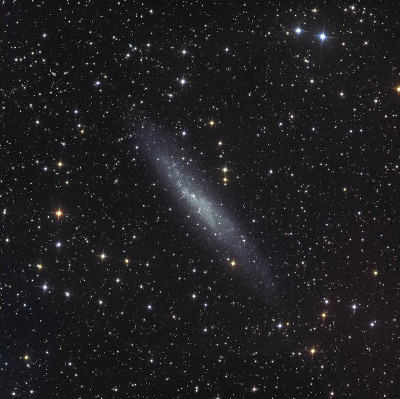
John Herschel discovered NGC 3109 = h3221 on 26 Mar 1835 and recorded "vF; vL; 12' l; 2' br; lbM; pos of axis 82.3°. See pl. V. fig 9." His position and description and sketch (Plate V, figure 9) matches this large edge-on.
Joseph Turner sketch NGC 3109 in Feb 1876 with the Great Melbourne Telescope, though his sketch shows the galaxy extending between the four stars off the north edge (which are not involved). A lithograph based on the sketch was never published. While searching for NGC 3109 on 9 Apr 1885 with the GMT, Pietro Baracchi discovered nearby ESO 499-023.
Although Sidney van den Bergh concluded in his 2000 book "The Galaxies of the Local Group" that NGC 3109 was just outside the Local Group, bur recent papers assume this galaxy (along with Sextans A, Sextans B and the Antlia dwarf) is at a distance of 4.2-4.4 million light, on the outskirts of the Local Group.
400/500mm - 17.5" (2/28/87): fairly faint, very large, very elongated 4:1 E-W, diffuse. Appears as a low surface brightness streak with very weak concentration.
900/1200mm - 48" (5/4/16): fairly bright, very large, very elongated 6:1 E-W, ~15'x2.5'. Contains a large brighter irregular core region but no nucleus. A mag 12.5 star is superimposed near the center and a number of fainter stars are superimposed. Overall the surface brightness is fairly low but patchy with several very small knots.
Near the southwest edge of the galaxy, 3.9' WSW of the mag 12.5 star, is a faint 12" knot, identified in SIMBAD as [BCP93] F3 H2 from the 1993 paper "The dwarf galaxy NGC 3109. I - The data". A faint 10" knot, listed as [BCP93] F1 H3, is 1.1' NW of the same star and another quasi-stellar knot (perhaps a faint star) is close northwest of the star. Finally, on the southeast flank of the galaxy is a faint larger patch, perhaps 15"-20", catalogued as [BCP93] F5 H1.
Notes by Steve Gottlieb